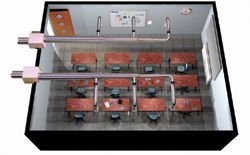On-demand ventilation with energy recovery makes perfect sense, says Nygel Humphrey.
Numerous studies over the years have demonstrated clearly that air quality has a direct impact on productivity, comfort and, in schools, on learning. So what's the best way to do something about it?
Current CIBSE best practice recommends a CO
2 concentration of no more than 900 parts per million (ppm) to achieve a medium quality of air. However, in the design of commercial buildings maintaining CO
2 levels is largely a trace element within the overall ventilation strategy. The exception is schools where guidance on CO
2 levels is integral in the design and control of the ventilation system.
Building Bulletin 101 specifies limiting CO
2 levels within teaching and learning spaces to 1,500 ppm. It would be helpful to take this guidance and place it at the centre of ventilation strategies in all buildings to set a minimum air quality standard and relate it to the occupation density of the space. To do this effectively, fresh air supply rates must be considered, and, in our view, these should be set at between 10-12 l/s.
Regrettably, fresh air supply rates per person in schools and other buildings are often so low that CO
2 levels are, in fact, well above this recommended level. For example, last year research from Reading University and University College London revealed that new energy efficient schools were being designed to be more airtight to reduce heat loss, but as a result the schools featured appalling ventilation rates with CO
2 levels exceeding targets.
Naturally ventilated buildings are often seen as the most energy efficient answer. Natural ventilation, of course, raises immediate air quality issues, especially in city buildings where outdoor pollutants are brought into the building from outside. It's also difficult to isolate external noise in these projects.
However, there are other problems too. Building Bulletin 101 requires natural ventilation in schools to achieve an airflow rate daily average of 5 l/s per child, a minimum level of 3 l/s and a maximum capability of 8 l/s with teacher intervention.
The inclusion of a minimum level (where, interestingly, no minimum level is specified for mechanically ventilated schools) is a tacit admission that natural ventilation struggles to achieve the daily average and maximum capability levels required for schools.

Sentinel in a classroom setting
Because it is difficult to put resistance into the system, there is limited capability to recover heat or coolth in a naturally ventilated building either. Instead, more energy is needed to provide top-up heating to the fresh air brought into the building in Winter or it is simply exhausted to outside when it could be put to other uses in Summer.
Mechanical demand ventilation responds to the exact ventilation demands of a room, supplying or extracting air only when and to the level it is required. Sensors communicate with the main unit which, in turn, drives the fan to the required speed to deliver the airflow and respond exactly to individual room conditions.
Since the system is demand controlled, rarely does it operate at full power for any considerable length of time to achieve the desired indoor air quality level. A fan running at 80 per cent speed only uses 50 per cent of the energy of one running at full speed. As a result, on-demand ventilation is much more efficient than intermittent fan operation and represents the perfect choice for spaces where occupation density varies, such as, offices, theatres, conference rooms and classrooms.
Recent changes to iSBEM will prove helpful for contractors. In the previous version of SBEM, demand-controlled ventilation could be represented, but required the calculation of parameter values. In the latest version of the compliance tool, contractors can now select on-demand ventilation as part of their zonal control strategy, coinciding with the formal recognition of this control technology in the latest Building Regulations and the energy benefits it brings, while guaranteeing indoor air quality.
The latest on-demand ventilation systems integrate 90 per cent energy recovery into the ventilation system. This type of system extracts the energy from the warm, stale air taken from the space before it is exhausted to outside while fresh, incoming air is preheated via the high efficiency plate heat exchanger and supplied into the classroom. The energy recovery process is proven to use up to 94 per cent of the heat energy which would otherwise be wasted to outside.
An automatic summer bypass takes advantage of any free cooling available when the ambient temperature is below the room design condition, typical in Spring and Autumn.
The Sentinel Totus Demand Energy Recovery Ventilation (D-ERV) system from my own company also incorporates interlocks for associated heating and cooling equipment installed to optimise energy recovery potential and eliminate any possibilities of systems conflict. A night-time purge facility takes heat from the room overnight in the summer to reduce start up temperatures and help cut over heat from non air conditioned spaces, or reduce air conditioning start-up loads in air conditioned spaces.
Comparative studies we have taken based on an outside ambient of -4 deg C and a desired room temperate of 18 deg C, an airflow rate of 5l/s per person will ensure that CO
2 levels will not exceed 1500 ppm. However, if natural ventilation is used, the result will be a total energy lost to ventilation of 4.04 kW/hr per classroom whereas the equivalent figure for demand ventilation with energy recovery will be just 0.83 kW/h. And that's with the fans running on the mechanical system.